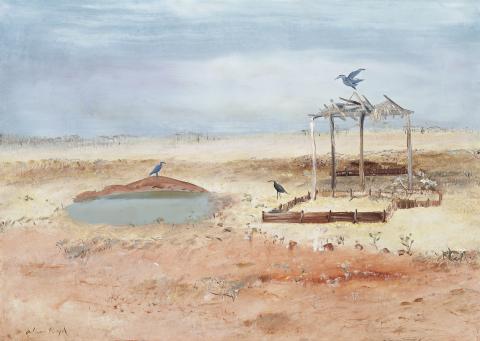WIMMERA LANDSCAPE WITH WATERHOLE, BIRDS AND SHELTER, c.1950
ARTHUR BOYD
oil and tempera on composition board
87.0 x 121.0 cm
signed lower left: Arthur Boyd
Guelda Pyke, Melbourne
Thence by descent
Private collection, Melbourne
In this shimmering painting, Arthur Boyd captures a quiet vista in Victoria’s north-western wheatbelt region known as the Wimmera. Thomas Mitchell, who surveyed the area in the mid-1830s, named it after a word from the local indigenous language meaning 'throwing stick', and it now includes such towns as Horsham, Dimboola, Nhill and Ararat. In the mid-20th century, it also possessed an abiding sense of solitude with ‘so little to break the vision (that) the whole landscape appears to surround you everywhere except the particular minute patch that is yourself.’1 Boyd first visited Horsham and the Wimmera in the summer of 1948-49, travelling in the company of the poet Jack Stephenson. Here, he painted landscapes at the border of the Wimmera River and would return several times over the next years.
Landscape painting was a major preoccupation for Arthur Boyd from his earliest days on the Mornington Peninsula in the company of his grandfather, the artist Arthur Merric Boyd (senior). Alternating between impressionism and expressionism in technique, Boyd began reinterpreting biblical stories set within Australian locales which alternated between chaotic urban sprawl and tangled scrubby bush. In the mid-1940s, Albert Tucker loaned Boyd a copy of Max Doerner’s The Materials of the Artists and Their Use in Painting with Notes on The Techniques Of The Old Masters, a handbook he pored over with his colleague John Perceval. Doerner’s book had already informed legions of practitioners since being published in 1921, and the two young artists enthusiastically experimented with some of its suggested media. One in particular was tempera, which is classically a mixture of egg yolk, oil, water and pigment (though casein emulsion may be used instead of egg). It must be used quickly and provides a matt, smooth surface, though some artists choose to apply varnish afterwards. The technique has a rich history dating from the fayum funerary portraits of 1st Century Egypt, through to such artists as Botticelli, the Pre-Raphaelites, Andrew Wyeth, Giorgio de Chirico and Howard Taylor. For Boyd, ‘the egg tempera … gave a new translucency to (his) paintings of the late 1940s, rather like the glazes he was using to decorate ceramics. One of the earliest using the new technique was The Golden Calf of 1946 2 where, through semi-transparent pigments, can be seen the chalky white ground, imparting a mysterious glow to the work.’3
By the time of the Wimmera trip, Boyd was well versed in the use of tempera and was able to harness its unique qualities for a small suite of paintings inspired by the experience. The nature of the medium also helped him retain the stark immediacy of the landscape, having absorbed Doerner’s advice that ‘(q)uick work and not too frequent overpainting heightens the effect of the (chalk-based) ground, which is therefore especially adapted for sketching purposes … and above all tempera painting.’4 In Wimmera Landscape with Waterhole, Birds and Shelter, c.1950 Boyd focuses on the scrubby minutiae of the land with its ramshackle shelter, dam and ubiquitous crows. An ominous sky hints at possible rain though this is often an unfulfilled and frustrating local illusion. However, as Barry Pearce notes, the endless wheat plains ‘are not by any means forbidding, nor forsaken. But in dry hot weather (they can) have, over sparse, unbroken horizons, a searing expanse of sky that elicit(s) an acute sense of the infinite’,5 a tenor that Boyd accurately conveys. The painting offered here was not exhibited in 1950 with its companions at either the Stanley Coe or David Jones galleries in Sydney and Melbourne, as Boyd gifted it to his artist colleague Guelda Pkye. However, others from those shows were bought directly by the Art Gallery of New South Wales, Sydney (Mid-day, the Wimmera, c.1950, 75.6 x 90.8 cm) and the National Gallery of Victoria, Melbourne (Irrigation Lake, Wimmera, c.1950, 81.3 x 121.9 cm).
The critical success of these paintings were integral to Boyd’s subsequent inclusion in the Jubilee Exhibition of Australian Art in 1951 and the later decision which awarded him the honour of being Australia’s representative for the Venice Biennale of 1958. Here, alongside works by the late Arthur Streeton, Boyd exhibited eight paintings, two of which were Wimmera subjects. Offered for the first time in 60 years, this painting is truly a significant rarity.
1. Sidney Nolan, letter to Sunday Reed, 24 May 1942, quoted in Underhill, N., (ed.), Nolan on Nolan, Penguin, 2007, p. 113
2. In the collection of Art Gallery of Ballarat, Victoria
3. Pearce, B., Arthur Boyd: retrospective, Beagle Press, Sydney, 1993, p. 19
4. Doerner, M., The Materials of the Artists and Their Use in Painting with Notes on The Techniques Of The Old Masters, Rupert Hart-Davies, London, revised edition, 1969, p. 11
5. Pearce, B., op cit., p. 20
ANDREW GAYNOR
